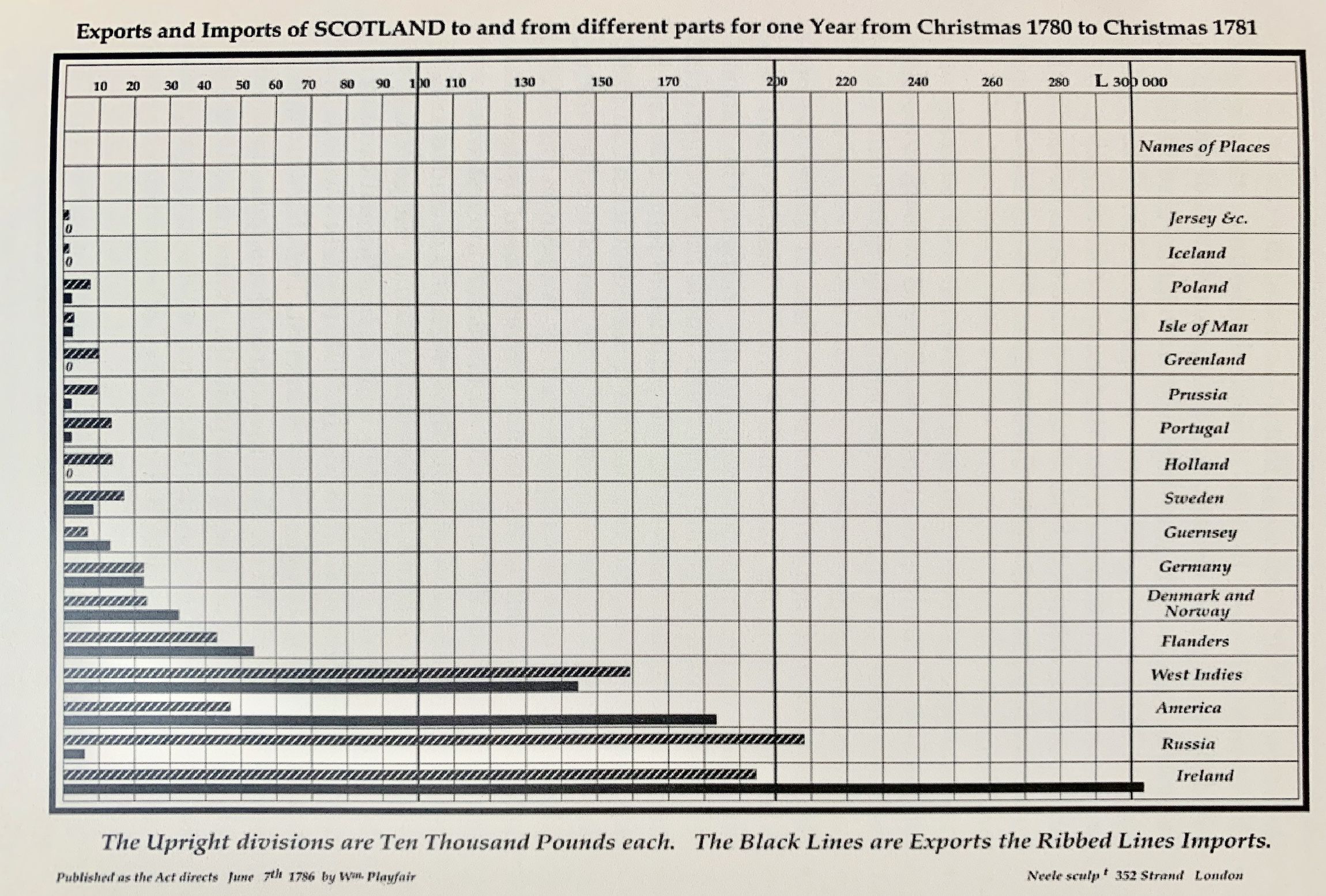Why bar charts still rule

I'm starting with a confession that's going to upset a lot of people. I make animated data visualisations for a living. But here's the truth. But every single animated chart I create gets destroyed by a simple bar chart.
Bar charts are faster, more accurate and easier to understand. They just work.
And that pisses me off. No matter how hard I try to innovate, I can't beat the humble bar chart.
Today I'm going to defend the the bar chart. Not that I want to. But I have to admit defeat. And I also need to understand why I’ve been defeat.
So consider this a confession. I am guilty in beliving I could better, but I can’t.
The bar chart is King.
Picture this. It's 1786 in Scotland, just a decade after the American Revolution. A chap called William Playfair sits at his desk with copper plates and engraving tools. He's frustrated. A bit like how I feel when I’m faced with a load of JavaScript on a rainy day.
The Americans had just overthrown their king. Now Playfair was about crown a new one – the bar chart.
So here’s what happened
He's working on his masterpiece, "The Commercial and Political Atlas." He's already filled it with dozens of ingenious line charts showing trade data over time. But now he hits a snag. He wants to show Scottish trade data, but he doesn't have enough historical records for a proper time series. All he has are import and export figures for different countries from a single year.
What does he do? He goes a bit crazy.
He draws rectangles. Simple rectangles of different heights. He calls them bars. Have a look below.

His colleagues think he's mad. His old boss James Watt dismisses his work as "mere plummery" and calls him "a rascal." The academic elite scoff. This after all is not how serious people present data.
But Playfair had declared independence from the old ways. Just like the Americans, he was fighting for freedom. Freedom from the tyranny of incomprehensible data.
Those simple bars he drew would become the foundation of how we see data today.
The racing bar chart wars
So what's the issue? Well, there's something I have to admit. We have a problem with trying to fix things that work perfectly well already. And we've done exactly that with the bar chart.
Where on earth did we get this crazy idea to animate bars and rank them over time?
It actually started earlier than most people think. YouTube channels like TheRankings began creating bar chart races as early as 2017, tracking everything from top global brands to gaming console sales. But the format truly exploded when John Burn-Murdoch of the Financial Times created his watershed moment in March 2019: an animated chart showing the most populous cities over time.
The bars moved.
They raced.
They told a story.
It went viral.
Soon YouTube was flooded with racing bar chart channels. Entire ecosystems emerged dedicated to ranking everything imaginable. The format was hypnotic. Addictive. Clickable.
But then the backlash began.
"They're an abomination," some muttered. "How can you seriously analyse moving bars against their axis? They're worse than pie charts."
The most vocal critic was Andy Cotgreave, senior technical evangelist at Tableau, who declared racing bar charts the "fidget spinner of data viz."
I'm not really sure if this was a criticism or just a joke. It certainly made me laugh. They're captivating to watch but they've hit their sell-by date, he argued.
Cotgreave's chief complaint is that, although such races can be attention-grabbing, he finds himself not retaining much of the information being put forth, or even knowing what piece of information is worthy of note, as the bars vacillate up and down. In a nutshell, it's information overload, with little to guide the eye.
Okay, so before we continue, here's an example of one that I've made recently. I come back to whether these critism are valid later.
Ok so now you know what a racing bar chart is. Let’s continue.
The criticism against racing bar charts reached boiling point in November 2019 when Reddit's r/DataIsBeautiful (the internet's most popular data visualisation community with over 20 million members) did the unthinkable. They banned racing bar charts entirely.
"The subreddit is currently experiencing a large surge in racing bar charts," moderator AskLubich announced. "We implemented a moratorium on racing bar charts, due to persistent spam issues and because they have become too prolific in this subreddit."
The moderators had been wiping an average of 20 posts per day. The ban would later extend to charts created with Flourish, the popular racing bar chart tool, after spammers discovered it was "dead easy to make racing bar charts on there and to use those charts to promote spam".
Users were divided. "Hallelujah I despise racing bar charts," wrote one user. "I didn't mind some of them if they were actually interesting," replied another.
But here's where it gets interesting. The debate wasn't just about spam. It was about something deeper: the fundamental tension between entertainment and analysis in data visualisation.
The defence
Not everyone was ready to write off racing bar charts. Mike Bostock, creator of D3 and co-founder of Observable, offered a more nuanced view.
If you've never heard of him, he's pretty much the person who made animated trending charts possible because he developed a JavaScript library called D3. This was the same JavaScript library that I used when I began to create my own charts.
"There are good things about bar chart races that are perhaps not always considered if you're taking a purely rational perspective," he said. Movement naturally grabs the eye. They're intuitive. Time is mapped to time, which cuts down the intimidation factor.
That emotional resonance is the driving force behind the appeal of bar chart races. As in any race, there's an element of mystery and anticipation. "Not everything is visible upfront, and the waiting gives you a bit of an emotional investment. If you knew the winner ahead of time, you probably wouldn't watch it."
Research backs this up. A 2008 study found that participants who viewed animated visualisations read values less accurately than those who viewed static visualisations, but not dramatically worse. At the same time, participants enjoyed the animation more. Users repeatedly reported that the animation condition was 'fun' or 'exciting' or, in one case, 'emotionally touching'.
Even the racing bar charts' harshest critic had to acknowledge this appeal. Cotgreave admitted: "Animation creates drama: moments of crisis and moments of conclusion." His employer Tableau eventually added support for racing bar charts. "I've got a blog post decrying them, followed by a blog post on how to build them in Tableau," said the style's most vocal critic. "Which one got the most hits? Of course it was the one on how to build them."
Why it matters
I think Mike Bostock explained why racing bar charts are so popular very well. Data visualisation has never been just about analysis. It's also a way to express yourself. To communicate the complex in a way that people can understand.
If you've noticed my own pieces, I use storytelling and music together, because this is what makes us human. Racing bar charts are just as much a form of human expression as they are a tool for data science.
What is the point in having a static bar chart that is easy to analyse, if the audience finds it boring and doesn't analyse it? You don't really get your point across, which means your chart is a failure.
It's true that a static bar chart is hands down one of the best forms of data visualisation out there in terms of its robustness and ease of use. But it's not necessarily what people want to see. It's not necessarily the most popular form of data visualisation.
What most of my followers don't realise is that I do static charts all the time. They just engage more with the racing bar charts than the static ones.
The final word
The irony is that today's racing bar charts face the same resistance from purists that Playfair faced from the academic elite of his time when he introduced the bar chart.
The bar chart remains King because it works. But sometimes, even kings need to learn how to dance.
Innovation isn't about replacing what works. It's about expanding what's possible. Static bar charts for precision. Racing bar charts for passion.
The choice isn't binary. It never was.
